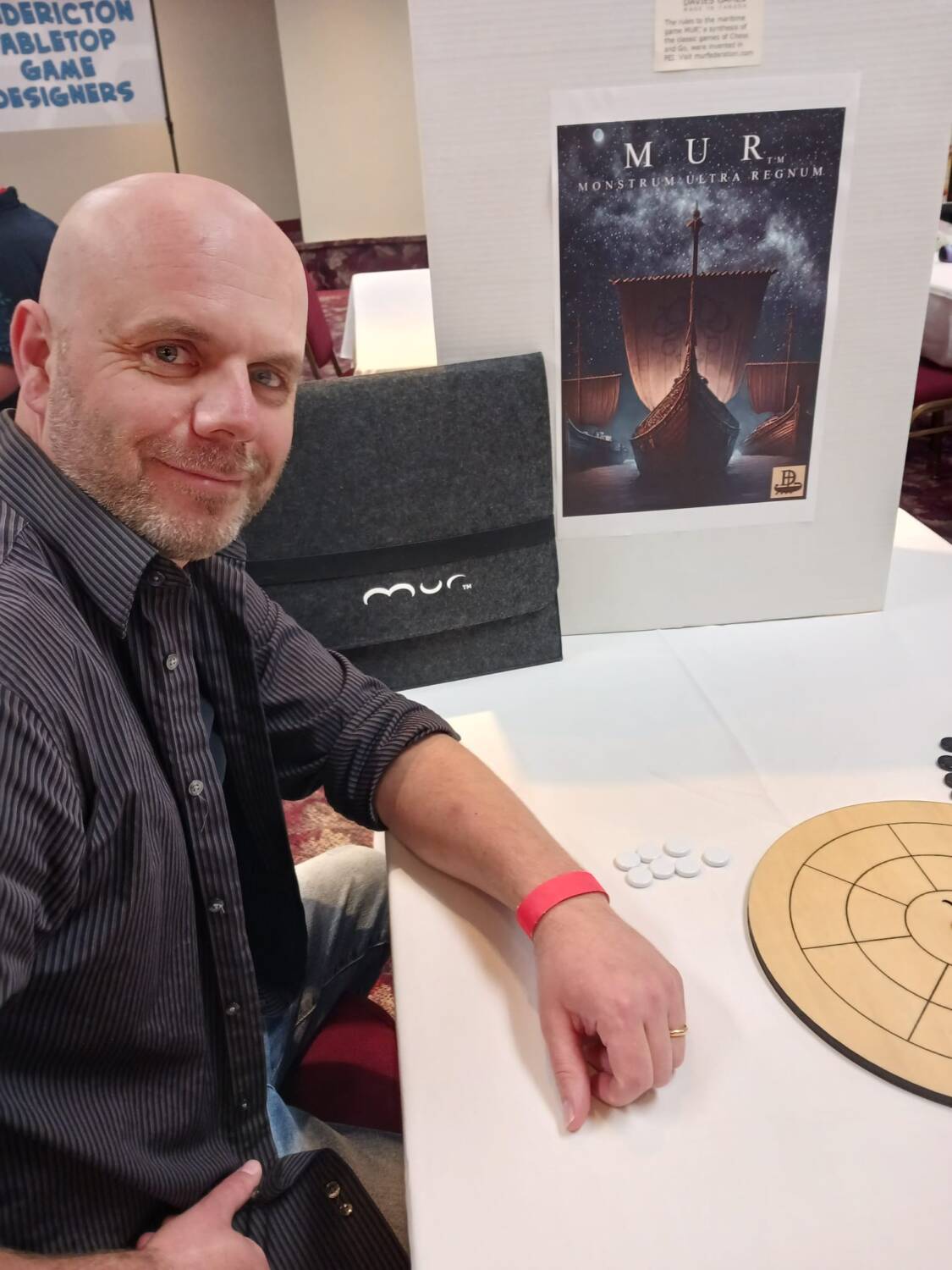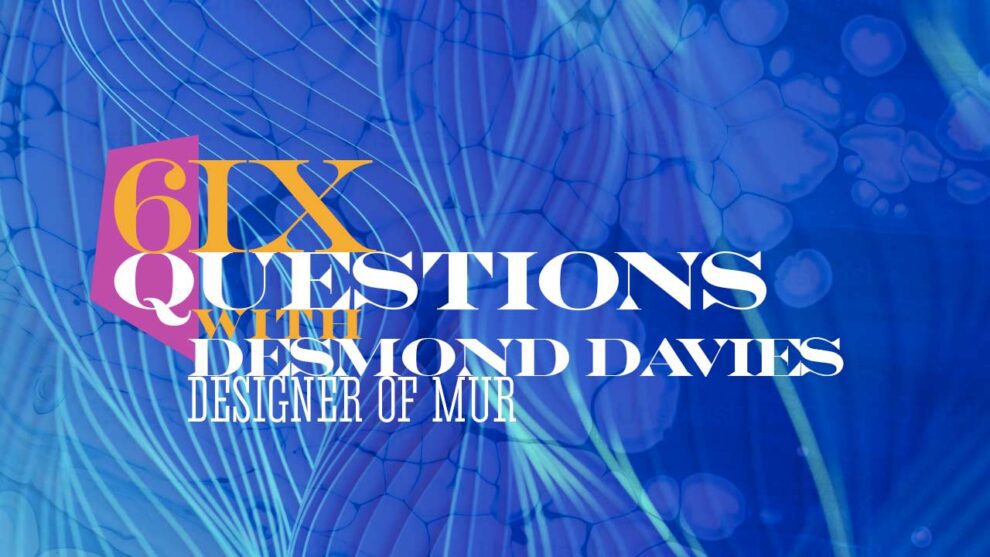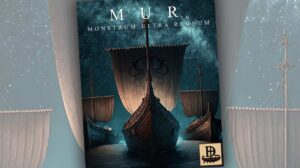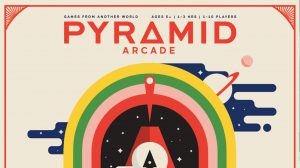During my time with Mur, I reached out to its creator, Desmond Davies, several times to better understand how Mur is played. We exchanged emails and spent about an hour on a Zoom session with Desmond showing me various aspects of the game in real time. I am very grateful and appreciative of the time he took with me.
A Word of Note: The copy of Mur that I received and reviewed was the original edition. It features black and white stones for the players and a neutral red stone. Desmond has recently released a new edition with round black and white pieces with ships on them and a single red piece with a kraken on it. Desmond makes reference to both editions in our interview.
Tom Franklin: What are your favorite games and why?
Desmond Davies: One night, during Christmas vacation, when my dad was a young boy in Ontario, the river outside their country home froze over. The next day, he and his visiting friends were able to skate for miles up and down the river. Later that night, after their great skating adventure, they all gathered around the fire and my dad was taught how to play Chess. It was a lovely Christmas memory that inspired my dad to introduce chess to me as a Christmas gift when I was in grade four. So growing up, my favorite game was Chess.

Three years later I got another game for Christmas: Dungeons and Dragons! Wow, I remember being very immersed in Dungeons and Dragons until I ran into a conflict with my friend’s mom who said that she would not tolerate any D&D in her home. My dad also refused to get me the next box set since he felt I was spending an unhealthy amount of time planning these crazy adventures.
So in my childhood I loved the idea of strategically hunting the king, but then also the exciting adventure of hunting down a great monster! So then, this is the childhood background behind the monster-hunting theme we finally chose for Mur just this year.
TF: What was the genesis for Mur and how did it change as you developed the game?
DD: It was on the third day of Christmas of 1998 that I came up with the idea of inventing a new version of Chess. I decided it would be a siege version with infantry, cavalry and artillery game pieces like in Risk. Being a siege, one army would face outward from the center facing the surrounding opposing army.
I thought that since the game involved an encircled fortress that it would be best if the game was a circle. I then made a great deal of circles—seven, I believe—alternating dark and light tiles like Chess, but it gave any viewer such a huge headache just to look at the board. So I decided to only darken the dark tiles with little pips like on dice. The rings were counted in this way with more pips as the game expanded outward so that the whole thing left the viewer with the impression of a domino-like starry expansion.
It was then that I thought that a cosmological theme would be better. So then I reduced the whole thing to three rings and then spent the next twenty-five years moving stones around trying to find the best code of play.
I almost gave up until I was greatly inspired by the book of Genesis to abandon different sizes of wooden ball-like pieces in favor of simple stones all the same size with Go-like surrounding rules. During the many years of contemplating the game it was my brother, Renaud, who suggested a neutral piece, so I incorporated this thinking it was a brilliant idea. This neutral piece would later become the kraken.
Oh, and I should add that in the beginning, when the game was looking like Risk, it was called ‘Rum‘. When it later changed to three concentric rings, I just reversed the letters to get the more cosmological sounding word ‘Mur‘. I could have changed this years later, but I decided to keep it when I realized that it works like a derivative of the Latin word Merelles which means counter piece; this hits the core mechanic of the game since the game pieces are counted to determine how far they move.
TF: What did you learn about the design process and what might you do differently with your next game?
DD: I learnt that it is possible to synthesize ancient foundational concepts. I will tell you that I wanted the game to have dice but I was competing with the design of Chess, so then I felt I had to keep it a perfect information game. In the end, I designed a game that synthesizes the ancient foundational concepts of dice and token: when playing you’ll note that the arrangement of the pieces act like the pips on a die and therefore determine how far a piece can move.
I also learnt that it is possible to embed higher order mechanics into the rules of play so that the player is forced to think at an analytical level; in Bloom’s taxonomy of cognition, this pushes the player’s mind into analysis, synthesis and evaluation. I am not aware of any other game that so heavily interacts with all the other pieces upon the board. I frequently hear people amazed at how challenging it is to move a game piece in Mur, since the consequences, as it relates to all the other pieces, are so holistic.
In regards to a next game, I’m definitely not interested in designing another game. Mur is my first and last game. Now that the game has been completed, it’s time to spend the rest of our lives building up the culture of the game. I am currently working on getting a contract on our first book since, of course, the game is rich with puzzles and tactics to last lifetimes. We have already begun to introduce the game to Japan. Next will be France.
TF: What was the thinking behind Mur being played in two sets of six games?
DD: One of our goals is to promote Mur until it becomes the canonical example of a game where man is dominant over AI. Deep Blue versus Garry Kasparov was a pair of six-game chess matches. Since Mur has been designed to be an AI proof game, we repeat the circumstances of that significant match. Having done so, it has enabled me to introduce asymmetrical setups which create a massive game tree. I have a built-in reset of the neutral piece alone, therefore keeping most of the final game position of the last game as the beginning setup for the next game.
Basically, there are over 54 billion possible ways to arrange the game pieces on a Mur board. Now, with the kraken limited to the center, you still have over a billion possible arrangements for a beginning setup from the second game onwards. Having an exponentially gargantuan game tree creates an environment where creativity is the priority and not memorization.

TF: We’ve both been teachers. As someone who taught Chess to children for years, I can see potential for Mur in a school environment. What do you think Mur’s potential is in that situation?
DD: Yes, I’m glad you agree that Mur has the potential to be a real scholastic presence in the school system. In fact, we were just contacted the other day by a librarian in Montreal, who is introducing Mur to three different schools. As teachers, I would like to think that we understand the importance of higher order thinking. A student may know something, but does that student understand what is known? Something may be understood, but is it understood enough so as to apply that understanding to solve a new problem?
Now these are all lower order thinking skills so far, but, next, can a student analyze the relationships of all the parts that came together to solve the problem? That is the beginning of higher order thinking. This kind of higher order analysis of the relations between various parts has to be taught, instilled into a player by a teacher or special coach; however, in Mur, the relationships of the various playing pieces are so intense that it can be said that this sort of thinking is actually embedded into the very code of play itself so that the student is, through discovery learning, almost forced to reckon with it. So it can be said that the game very quickly elicits higher order thinking skills through the perfect activity for young minds: a fantastic monster-hunting game.
TF: What is a question about Mur, your design process, and/or becoming a game publisher that you wish someone had asked you? (And what’s the answer?)
DD: No one has asked me how I didn’t go insane spending over a quarter-of-a-century staring at three concentric rings and a handful of stones. The beginning was horrible. It felt like my brain had been soaking in water from the extreme abstract, intuitive effort required to discover the basic non-capturing concept. Actually, I’m just now realizing something after all these years: you see, Mur is an open system because it recycles in on itself—there’s no capturing of pieces. It’s like the laws of thermodynamics where heat and matter are entering and exiting a water container. You see how Mur correlates to an open system in thermodynamics? The heat correlates to the cognition of the players inserting and releasing pressure into the mechanics of the game play and the game pieces are like the entering and exiting of matter. See? I guess that’s why my brain felt like it was pressured and soaked!
Your brain too, by the way, Tom. I’m saying this because I found out that you’ve written a book called The Pterrible Pteranodon about a monstrous steam engine AI-like creature. That thing would have had a steam-engine brain! So I guess your brain’s like a steam engine as well to have thought of that story. Thankfully, I didn’t go crazy under the stress and I think the reason is that when our brains are working like steam engines, they also rest in Jacuzzis.
TF: Wow. I’ve never had anyone plug my book like this before. Thanks!
My thanks to Desmond for taking the time to answer my questions. I hope you’ve found his answers as interesting as I did.











Add Comment